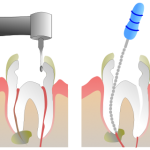 A trip to the dentist isn’t something that we look forward to, but proper dental care and treatment can lead to an overall healthier lifestyle. Two of the most common procedures that you may be faced with in your lifetime are either a root canal and/or a crown. These are basic procedures that are performed every day in dentists’ offices around the world. In this article, we will cover the most common questions attributed with these two procedures, such as what they are and why you may need them.
A trip to the dentist isn’t something that we look forward to, but proper dental care and treatment can lead to an overall healthier lifestyle. Two of the most common procedures that you may be faced with in your lifetime are either a root canal and/or a crown. These are basic procedures that are performed every day in dentists’ offices around the world. In this article, we will cover the most common questions attributed with these two procedures, such as what they are and why you may need them.
The first procedure that we are going to discuss is the root canal. If a tooth has just a small amount of decay, the cavity will be handled by a filling. But in cases where a tooth is infected or has become further decayed, a root canal will be performed. This procedure can save your tooth from falling out or even decaying the teeth around it. In this treatment the pulp of the tooth is removed and the root is completely emptied out/cleaned.
The center of the tooth is the area called the root canal. The pulp is the soft tissue that surrounds the tooth’s nerve. The role of the nerve is no longer prevalent once the tooth has protruded through the gums. In other words, removing the nerve from a tooth will not affect the tooth’s functioning.
The pulp of the tooth can become damaged, which can allow bacteria to form inside the pulp chamber and begin to infect the tooth. This can lead to many tooth and gum problems if not treated properly.
So how do you know if you need a root canal? Well, there are not always symptoms that are present, but there are some signs that may point to a possible infection. These symptoms can be: tooth pain when chewing, sensitivity to temperature, or even discoloring around the tooth. Regular dental checkups will catch these problems before a root canal is necessary.
The root canal procedure can be performed by a dentist or an endodontist (infection specialist). A local anesthesia is performed and an access opening is drilled into the tooth so that inflamed or infected pulp(nerve) tissue can be removed. There can be 1 or more canals that are cleaned, shaped and sealed and you are on your way home!
The second procedure is a dental crown. This is a process that can repair damaged teeth and also improve the visual appearance. Crowns are made of many different materials but they all serve the same purpose and cover the full tooth (unlike a filling which only covers a portion). These crowns are permanent and are cemented into place.
The procedure for a crown can take at least 2 visits. The first visit involves the shaping of the tooth, the tooth impression, and the temporary crown.
Like most dental procedures, local anesthesia is used. In order for the crown to fit properly, the tooth must be shaped and trimmed properly for the hard crown to fit. This proper fit will enable the crown to last longer and be more stable.
The tooth impression is the second important step in the process, in which the dentist takes a molding of the tooth to be crowned. The dentist then sends the impression to a dental lab for the crown to be fabricated, which can take about one to two weeks. The temporary crown is then placed on your tooth for the time in between your visits.
The second visit is where the cementing and placing of the final permanent crown is done. This process is very simple and involves placing the crown on without any cement to get the fitting just right and making any minor changes before finalization. The dentist will place the cement on the tooth and place the crown on, then clear off any excess cement. That is the final step and your new crown is set to last about five to fifteen years!
These two simple procedures are reasonably pain-free and help keep your gums and teeth healthy for your whole life.
